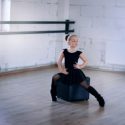(Guest Article) Art Smart: Learning Disabilities and Creative Expression
November 24th, 2018 | Posted by Alaiyo
Whether your child has a mild learning disability or a severe cognitive impairment, there are many ways they can benefit from engaging with the arts. From painting to performing, children of all abilities have much to gain from tapping the creative side of their brain.
Brushstrokes and Building Skills
Contrary to popular belief, your child doesn’t have to have Picasso-level skills to enjoy artistic endeavors. Cecilia Cruise, a Florida-based occupational therapist with more than 25 years’ experience with special needs children, explains that art education offers children with learning disabilities the opportunity to build their self-esteem while enhancing problem-solving and fine motor skills. Children with autism and attention deficit disorders benefit from art, as it can help reduce stress, increased self-awareness, and develop valuable interpersonal skills.
ADDitude, a magazine geared toward children with ADHD and their families, explains that the self-expression achieved from artistic creation is also beneficial in helping children address emotional problems. It should be noted that there is a difference between art education and art therapy. Art education focuses more on technique, whereas art therapy stresses the use of creativity as it relates to emotional and academic adjustment.
Activities to try: dot painting, self-portraits
Crafting and Cognition
Crafts like beading and paper mache can help develop skills like dexterity, foster independence, and provide a way for nonverbal children to communicate their thoughts and feelings. Craft activities are good for children for a lot of other reasons too. They are usually relatively inexpensive, can be done year round in any type of weather, and they are easy to modify for children of all ability levels.
According to NY Metro Parents, crafts are also an excellent way for children with special needs to build self-esteem. The seemingly simple act of creating a keepsake or a gift can help kids who are not achieving the same goals as their siblings or peers feel the same sense of accomplishment and success. Be prepared to offer your child encouragement and help along the way, but allow them to do as much of the project as they are able on their own.
Activities to try: sewing, stamping
Dancing and Disabilities
If for no other reason, children with disabilities should be encouraged to pursue dance because it’s fun. But even more than that, dance promotes social inclusivity and is a form of exercise that can be tailored to the performer’s abilities. Carol Greenstein, the mother of a child with Down syndrome, says dance classes benefited her child by helping to improve motor movements.
Children with co-occurring physical disabilities can also benefit from dance. Adaptive dancing, which is popular for children in wheelchairs, is practiced across the country in inclusive settings that combine able-bodied students, those with learning disabilities, and children with severe mobility handicaps.
Activities to try: freestyle dance, ballet
Passionate Performers
Children with learning disabilities that inhibit their linguistic aptitude can benefit greatly from the performing arts. Studies have shown that the arts – and particularly those that involve the theater – improve receptive language skills and reading comprehension. Mark Ruffalo, who is famous for portraying Hulk/Dr. Bruce Banner in the Marvel Cinematic Universe, suffered from dyslexia as a child. He says acting chose him and gave him the chance to use his particular talents, which are apparent, considering he is one of the most recognizable faces on screens both large and small.
Acting is a common profession among people with learning disorders. In addition to Mark Ruffalo, Jay Leno, Vince Vaughn, Keanu Reeves, and Keira Knightley have all been diagnosed with dyslexia. Even the world’s most famous wizard, Harry Potter, played by Daniel Radcliffe, suffers from a mild learning disability, dyspraxia. This inhibits Radcliffe’s ability to perform even common actions, such as tying his own shoelaces.
Activities to try: host an at-home play, create voice-overs for stop-motion films
Music Masters
According to the Disabled World, “Music therapy is an effective educational and therapeutic tool for both children and adults with forms of disabilities.” Music therapy has many forms and may include anything from simply listening to soothing tunes to singing and playing an instrument. Music has the power to calm nerves and evoke memories and has even been used to promote lucidity in Alzheimer’s patients.
Playing an instrument can increase a child’s concentration, help them understand sequencing, and improve hand-eye coordination. When selecting an instrument for a child with learning disabilities, don’t assume that their instrument of choice is too complicated. Before selecting an instrument, swing by a local music store and let them get a feel for what they like.
Activities to try: clapping to rhythm, playing the keyboard
Just because your child has a disability does not mean that they can’t excel at doing something they love. And with so many options, your learning-disabled child is sure to find an artistic endeavor they enjoy that will benefit them in the most valuable ways possible.
Image via Pixabay

1818 Newkirk Avenue #4C
Brooklyn, NY 11226
(917) 733-0469 (917) 733-0469